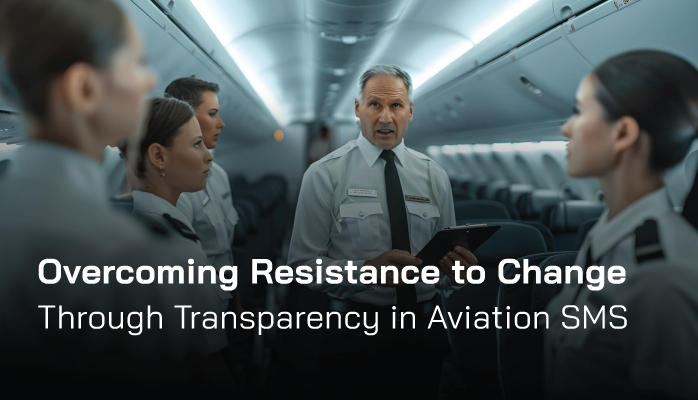Transparency Is a Hot Topic

Many of the major news headlines in the last few years have circled issues of transparency. From major corporations to our government, practices of secrecy always come back to bite management in their tender spots.
Aviation organizations that practice transparency tend to send a message of "non-corruption". These forward-thinking operators realize how corporate culture kills aviation safety culture.
What I find most interesting is that as a topic, transparency in aviation safety management systems (SMS) safety culture is as much an issue as it is in major headlines.
Related Articles on Aviation Safety Culture
- What Is Safety Culture in the Aviation Industry?
- How Your Corporate Culture Kills Your Aviation Safety Culture
- How to Monitor Aviation SMS' Safety Culture Performance
When aviation safety managers are setting up and implementing their SMS, the most common questions we generally receive are issues that are directly relevant to transparency, such as:
- Who should see this?
- When should they see it?
- How should I set this up?
- What information barriers should I have and where should they be?
Transparency Shows in Practice & Structure of Aviation SMS
At its core, transparency is expressed both in the practice of individuals and in the structure of the SMS. I believe that one affects the other significantly. The structure of your aviation SMS definitely affects the behavior and attitudes of employees and management.
What Is Transparency in Aviation SMS?
The central philosophical question of transparency in aviation SMS is this: how much access to safety information do employees at all levels of an organization have?
As an ideology, safety transparency is incredibly straightforward.
- In transparent work environments, if safety information about Issue X is available to the relevant workplace populace, then that organization is practicing transparency
- In non-transparent work environments, safety information about issue X will not be available to the relevant workplace populace – indeed they probably don’t know Issue X even exists
Of course, ideology and the everyday practice of absolute transparency are entirely different things. Let’s face it, issues in aviation SMS can be:
- sensitive,
- messy,
- and there will be occasions when absolute transparency is not best for the SMS.
Each organization will have to establish its philosophy on transparency. However, in general, though the thought of making a particular issue public is frowned upon, a transparent work environment will make such information public almost every time to affected employees.
In a highly transparent work environment, information that is withheld is often done so only pending some kind of investigation, at the conclusion of which the information is released.
The Great Aviation SMS Frustration: Resistance to Change

Change is an inevitable and often frustrating part of the drive towards a healthy aviation SMS. Change is uncomfortable. Employees get used to methods, procedures, and duties, and changing those things means upsetting the daily flow and balance that employees are used to.
So resistance to the changes brought upon by an SMS implementation is completely understandable. While it is understandable, that does not excuse bad behavior or unacceptable resistance to the organization's SMS.
When employees and/or management resist changes, it can be an extremely unpleasant experience for aviation safety managers. Many safety managers deal with resistance on a daily basis. Resistance can take many forms:
- Apathy
- Friction in relationships
- Gossip and rumor starting
- Downright refusal to adapt to changes
- Graffiti on safety promotion posters
- Avoidance of SMS tasks
- Lack of compliance with risk management processes
- Lateness or absenteeism from safety meetings
Truly, prolonged resistance is a plague for the health of aviation SMS. If safety managers don't find ways to overcome resistance to change, the momentum and growth of the SMS will stagnate.
All changes, even large changes, should be broken up into small, easy-to-manage, bites. This will at least make enacting the changes feel less like “change” – the changes will creep up and accumulate over time rather than jarring employees all at once.
Related Articles on Resistance to Change
- How to Reduce Resistance to Aviation SMS With Difficult Employees
- 4 Tools to Find Resistance to Your Aviation SMS – With Free Resources
- Checklist to Quantify Resistance to Your Aviation SMS
Transparency, Just Culture, and Commitment
At a 32,000-foot overview, the most basic relationship between transparency and overcoming resistance to change is that of management’s commitment to just culture.
Aviation SMS implementations are top-down, meaning that aviation SMS is initiated and supported by the accountable executive. The accountable executive has a lot at stake here, more than the other actors on the stage. Accountable executives must ensure the SMS is properly implemented and working as designed across the entire organization.
Employees' attitudes and interactions with the SMS largely reflect how management treats the system. Safety culture is consequently a reflection of management's culture.
When management maintains a high level of transparency in their safety culture, the message to employees is that management is willing to sacrifice their ability to exercise control and secrecy for the health of the SMS.
Sacrifice is a powerful message – it empowers and moves people.
In essence, an employee’s resistance to change is also an outlet for him/her to exert control over a situation.
It sounds a bit strange to look at it that way. But no matter how you look at it, change is a top-down process and the line between “enforcing” change and giving “incentive” to change is very sensitive.
When management demonstrates sacrifice through transparency as a vehicle for just culture, the impression is that changes are not made as a means of enforcement, but as an incentive for safety. This single fact alone can be enough to tip the scales of resistance and compliance in aviation SMS.
More Articles on Aviation SMS Safety Culture
- 6 Signs of a Mature Aviation Safety Culture - With Resources
- How to Tell Your Safety Culture Needs Help? - With Aviation SMS Resources
- Examples How to Improve Safety Culture in Aviation SMS - With Resources
Transparency Means Involvement

In addition to sending a message of sacrifice, the natural result of transparency is a safety culture of inclusion. That is:
- The workplace as a whole is in tune with issues
- The relationship barrier between management and employees is thin
- Employees and management are involved with issues together
More simply put, transparency breeds a sense of togetherness. As I and others have pointed out in other articles, involving as many people as you can in an SMS implementation is one of the most effective ways to erode resistance to change.
When people feel involved, they feel that they are part of the change process as opposed to simply “having to comply.” Involvement is usually a combination of:
- Asking employees questions, such as through regular aviation safety surveys
- Engaging employees by simply talking to them and knowing who they are on a first-name basis
- Receiving input from employees through safety meetings, safety communications, and safety surveys
Basically, transparency = feeling involved = participation = reduced resistance.
By starting an SMS implementation with the goal of transparency, there will naturally be a smoother transition toward the new way of doing business. SMS is a new way of doing business. For safety cultures that distrust management, transparency may seem like a con. This is an incredibly important point. Management's gestures toward a transparent safety culture must appear genuine, and not contrived to merely satisfy management's need to get "that SMS thing implemented."
Related Articles on Aviation SMS Implementation
- Why Should We Implement Aviation SMS?
- Is Your Aviation SMS Implementation a Farce? With Self-Assessments
- How to Create Aviation SMS Implementation Plan - With Templates
Final Thought – Management and Employees
In writing this article, it has occurred to me that an underlying issue in topics of transparency is the constant struggle to unite the safety values, safety concerns, and safety sympathy of
- Employees and
- Management
When management and employees are on the same page, aviation SMS tend to flourish – that is unless both parties are on the same page in their disinterest in the SMS's success.
Uniting management and employees on issues of safety takes a tremendous amount of work on the part of the safety manager/team/department.
Moreover, it’s not a struggle that is ever “solved.” It will be a constant effort as management and employee turnover. Over time though, when both parties are in sync, the struggle to keep them united will be much easier.
My point here is that there are many ways to understand what safety transparency is and how it works in the aviation safety workplace.
Evaluate your safety culture using this checklist. Continuously monitor safety culture performance to help demonstrate continuous improvement of the SMS.
Last updated in December 2025.







